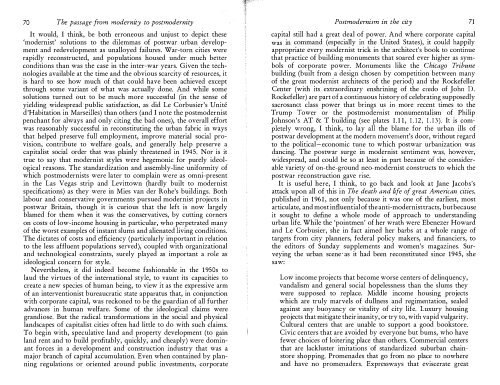The Condition of Postmodernity 13 - autonomous learning
The Condition of Postmodernity 13 - autonomous learning
The Condition of Postmodernity 13 - autonomous learning
Create successful ePaper yourself
Turn your PDF publications into a flip-book with our unique Google optimized e-Paper software.
70 <strong>The</strong> passage from modernity to postmodernityIt would, I think, be both erroneous and unjust to depict these'modernist' solutions to the dilemmas <strong>of</strong> postwar urban developmentand redevelopment as unalloyed failures. War-torn cities wererapidly reconstructed, and populations housed under much betterconditions than was the case in the inter-war years. Given the technologiesavailable at the time and the obvious scarcity <strong>of</strong> resources, itis hard to see how much <strong>of</strong> that could have been achieved exceptthrough some variant <strong>of</strong> what was actually done. And while somesolutions turned out to be much more successful (in the sense <strong>of</strong>yielding widespread public satisfaction, as did Le Corbusier's United'Habitation in Marseilles) than others (and I note the postmodernistpenchant for always and only citing the bad ones), the overall effortwas reasonably successful in reconstituting the urban fabric in waysthat helped preserve full employment, improve material social provision,contribute to welfare goals, and generally help preserve acapitalist social order that was plainly threatened in 1945. Nor is ittrue to say that modernist styles were hegemonic for purely ideologicalreasons. <strong>The</strong> standardization and assembly-line uniformity <strong>of</strong>which postmodernists were later to complain were as omni-presentin the Las Vegas strip and Levittown (hardly built to modernistspecifications) as they were in Mies van der Rohe's buildings. Bothlabour and conservative governments pursued modernist projects inpostwar Britain, though it is curious that the left is now largelyblamed for them when it was the conservatives, by cutting cornerson costs <strong>of</strong> low-income housing in particular, who perpetrated many<strong>of</strong> the worst examples <strong>of</strong> instant slums and alienated living conditions.<strong>The</strong> dictates <strong>of</strong> costs and efficiency (particularly important in relationto the less affluent populations served), coupled with organizationaland technological constraints, surely played as important a role asideological concern for style.Nevertheless, it did indeed become fashionable in the 1950s tolaud the virtues <strong>of</strong> the international style, to vaunt its capacities tocreate a new species <strong>of</strong> human being, to view it as the expressive arm<strong>of</strong> an interventionist bureaucratic state apparatus that, in conjunctionwith corporate capital, was reckoned to be the guardian <strong>of</strong> all furtheradvances in human welfare. Some <strong>of</strong> the ideological claims weregrandiose. But the radical transformations in the social and physicallandscapes <strong>of</strong> capitalist cities <strong>of</strong>ten had little to do with such claims.To begin with, speculative land and property development (to gainland rent and to build pr<strong>of</strong>itably, quickly, and cheaply) were dominantforces in a development and construction industry that was amajor branch <strong>of</strong> capital accumulation. Even when contained by planningregulations or oriented around public investments, corporatePost modernism in the city 71capital still had a great deal <strong>of</strong> power. And where corporate capitalwas in command (especially in the United States), it could happilyappropriate every modernist trick in the architect's book to continuethat practice <strong>of</strong> building monuments that soared ever higher as symbols<strong>of</strong> corporate power. Monuments like the Chicago Tribunebuilding (built from a design chosen by competition between many<strong>of</strong> the great modernist architects <strong>of</strong> the period) and the RockefellerCenter (with its extraordinary enshrining <strong>of</strong> the credo <strong>of</strong> John D.Rockefeller) are part <strong>of</strong> a continuous history <strong>of</strong> celebrating supposedlysacrosanct class power that brings us in more recent times to theTrump Tower or the postmodernist monumentalism <strong>of</strong> PhilipJohnson'S AT & T building (see plates 1.11, 1.12, 1.<strong>13</strong>). It is completelywrong, I think, to lay all the blame for the urban ills <strong>of</strong>postwar development at the modern movement's door, without regardto the political-economic tune to which postwar urbanization wasdancing. <strong>The</strong> postwar surge in modernist sentiment was, however,widespread, and could be so at least in part because <strong>of</strong> the considerablevariety <strong>of</strong> on-the-ground neo-modernist constructs to which the. .postwar reconstructIon gave nse.It is useful here, I think, to go back and look at Jane Jacobs'sattack upon all <strong>of</strong> this in <strong>The</strong> death and life <strong>of</strong> great American cities,published in 1961, not only because it was one <strong>of</strong> the earliest, mostarticulate, and most infl uential <strong>of</strong> the anti-modernist tracts, but becauseit sought to define a whole mode <strong>of</strong> approach to understandingurban life. While the 'pointmen' <strong>of</strong> her wrath were Ebenezer Howardand Le Corbusier, she in fact aimed her barbs at a whole range <strong>of</strong>targets from city planners, federal policy makers, and financiers, tothe editors <strong>of</strong> Sunday supplements and women's magazines. Surveyingthe urban scene as it had been reconstituted since 1945, shesaw:Low income projects that become worse centers <strong>of</strong> delinquency,vandalism and general social hopelessness than the slums theywere supposed to replace. Middle income housing projectswhich are truly marvels <strong>of</strong> dullness and regimentation, sealedagainst any buoyancy or vitality <strong>of</strong> city life. Luxury housingprojects that mitigate their inanity, or try to, with vapid vulgarity.Cultural centers that are unable to support a good bookstore.Civic centers that are avoided by everyone but bums, who havefewer choices <strong>of</strong> loitering place than others. Commercial centersthat are lackluster imitations <strong>of</strong> standardized suburban chainstoreshopping. Promenades that go from no place to nowhereand have no promenaders. Expressways that eviscerate great
















